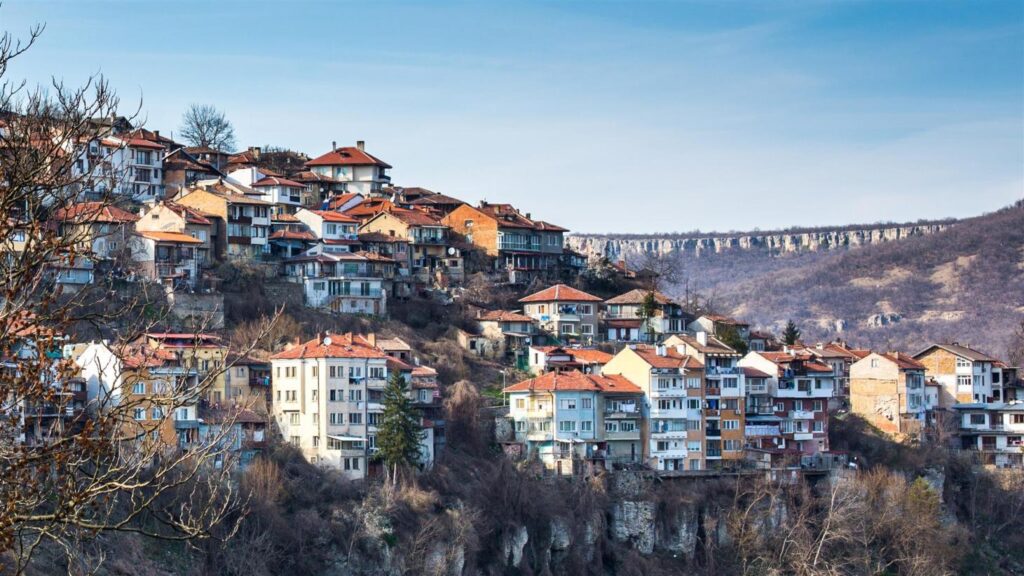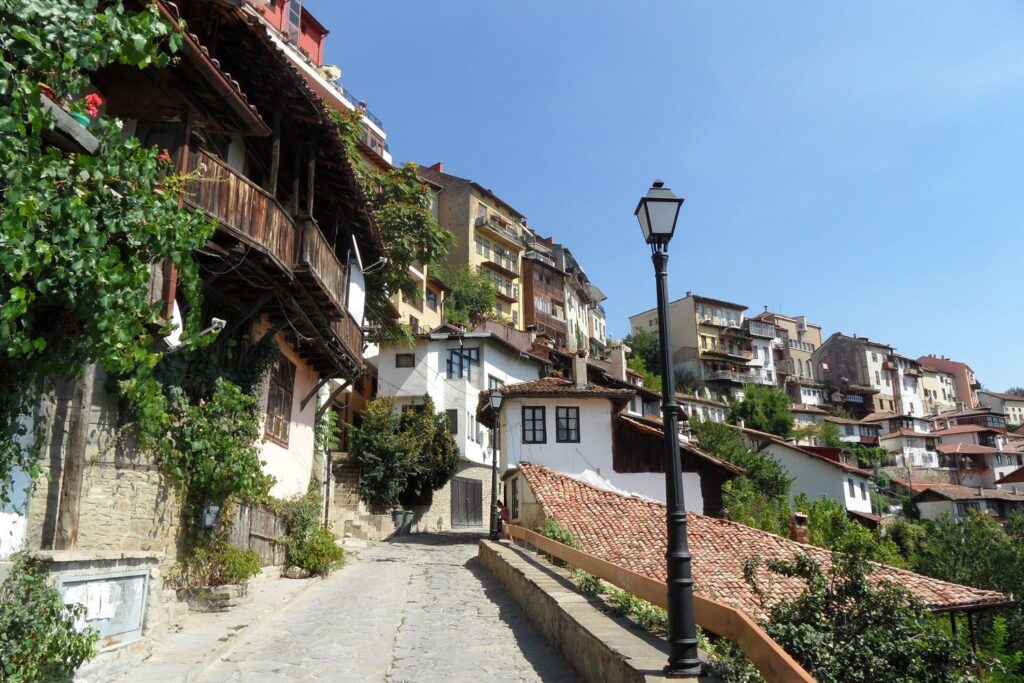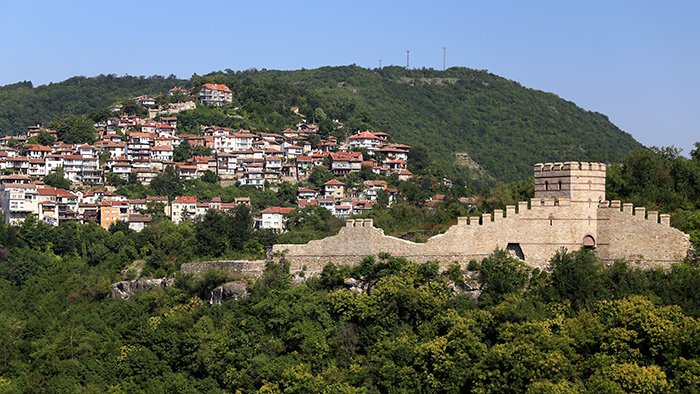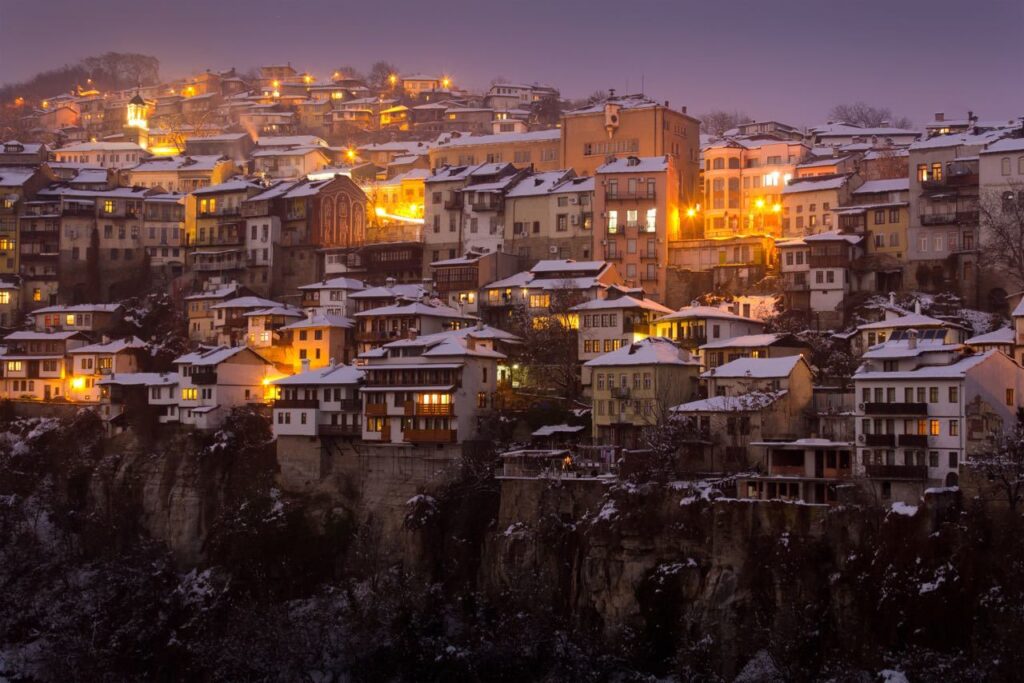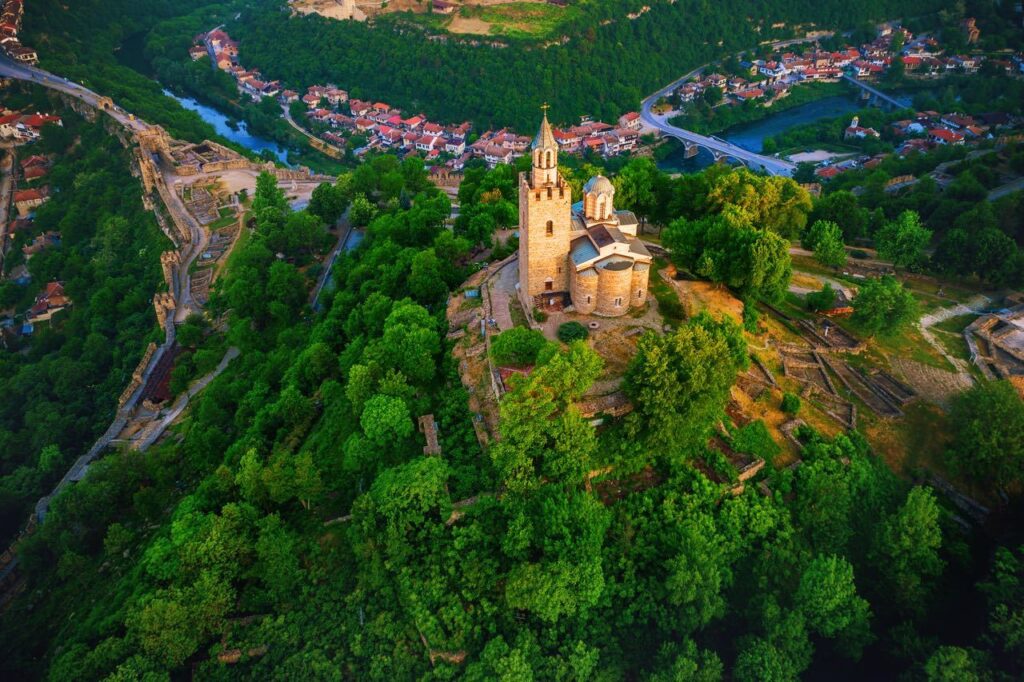Veliko Tarnovo is a town in north central Bulgaria and the administrative centre of Veliko Tarnovo Province.
Often referred as the “City of the Tsars“, Veliko Tarnovo is located on the Yantra River and is famously known as the historical capital of the Second Bulgarian Empire, attracting many tourists with its unique architecture. The old part of the town is situated on three hills, Tsarevets, Trapezitsa, and Sveta Gora, rising amidst the meanders of the Yantra. On Tsarevets are the palaces of the Bulgarian emperors and the Patriarchate, the Patriarchal Cathedral, and also a number of administrative and residential edifices surrounded by thick walls.
Trapezitsa is known for its many churches and as the former main residence of the nobility. During the Middle Ages, the town was among the main European centres of culture and gave its name to the architecture of the Tarnovo Artistic School, painting of the Tarnovo Artistic School, and to literature. Veliko Tarnovo is an important administrative, economic, educational, and cultural centre of Northern Bulgaria.
Symbols
The anthem of the city is Shishman’s song, dedicated to the last Bulgarian king of the Second Bulgarian Kingdom. The coat of arms of Tarnovo depicts a figure with three lions. Purple color was used for the flag of the city, because during the excavations in the church “St. Forty Martyrs “were found clothes of rulers in purple. There is also a key and a necklace of Veliko Tarnovo. The first known coat of arms of the city is from 1921 by Dimitar Bagrilov.
Geography
Location
Veliko Tarnovo has an area of 60.9 km². The area which is assigned to the town is 30.379 km². It is located on the river Yantra. The town has always had a strategic position. It is located on main roads which connect West Balkans with Black sea and East Europe with Middle East. In the East and North-East the town borders with the Arbanassi Bardo. North – with the Orlovets locality, to the west with the Kozludzha locality and to the south with the area Dalga laka.
Relief
The relief of the Municipality of Veliko Tarnovo is diverse – plain-hilly and mountainous. It is situated at 208 m above sea level.
Hydrography
The water catchment area of the river Yantra is 7862 km². There are several springs in the area of the town. The main drinking source is the Yovkovtsi hydro power plant.
Soils
The southern part of the city predominately features chernozem and gray forest soils. Repellents are also distributed – hummus-carbonate soils.[1]Yantra valley
Area
There are places around the town that keep their names for many years. Sini Vir is located to the west of the Cholakovtsi neighborhood in the Yantra River valley outside the town. Dervent is located in the Yantra River Gorge, near the Preobrazhenie Monastery. The Hill Golemyat duvar(Big Fort) with the highest peak 363 m. It is located between Veliko Tarnovo and the village Prisovo.
Hills
Veliko Tarnovo is situated on several hills. The Tsarevets, Trapezitsa, Momina krepost were the main centers of kings and boyars during the Second Bulgarian State, when the town was a capital. Sveta Gora (Holy Mountain) hill was a spiritual and literary center, and part of the today’s Rectorate of Veliko Tarnovo University. The Garga Bair hill lies north of Trapezitsa. On the Orlovets hill are the Varusha neighborhood and the Akatsion and Kartala districts, the highest point is 241 m above sea level. The Troshana Hill is located south of Sveta Gora and west of the Motela dam, and Veliko Tarnovo Hills is being built on it.
Caves
There are about 50 caves and rock niches around Veliko Tarnovo. They are formed in limestones from the Jurassic and Cretaceous periods. They are located mainly around the Arbanassi hill and the rock crown in the Dervent gorge.
Flora and fauna
Flora
The deciduous forests (88%) predominate in Veliko Tarnovo – beech, hornbeam, oak, cherry, lime, poplar, etc. There are woods of coniferous vegetation. They predominate fir tree, Pine, Abies grandis, Scots pine, Abies pinsapo and other. Near the river, the springs and the marshlands are seen: Green algae, Diatom and others. Over 25 types of mushrooms are encountered: Boletus edulis, Agaricus campestris, Macrolepiota procera, Chanterelle and others.
Fauna
The territory of the region has a rich variety of the animal world – 350 species of birds and 35 species of animals. Mammals include Hare, Fox, Deer, Wild boar, Hedgehogs, European ground squirrel. Birds include: Grey partridge, Crow, Common quail, Pheasant, White stork, Eurasian eagle-owl, Goose and others. Over 180 species of insects are encountered: Cockchafer, Grasshopper, Firefly and others. There are also reptiles: Turtles, Snakes, Lizards and others. Local fish include Wels catfish, European perch, Common carp, Common barbel.
Tourism
In 2013, 450,000 tourists visited the city. The most popular landmark is the historic hill Tsarevets, which held the capital of the Second Bulgarian Empire. A number of other sites also attract tourists, including the historic hill Trapezitza, the Samovodskata Charshiya, numerous medieval and Bulgarian Renaissance churches, and the ancient Roman fortress of Nicopolis ad Istrum.
Museums
In the city are located the architectural reserves: Tsarevets, Trapezitsa and Momina krepost. The Regional historical museum in the town were established in 1871. In the town are located the House Museum of the Bulgarian writers Petko Rachov Slaveykov and House Museum of the writer Emilian Stanev. Next to the Regional Library is located the Archaeological Museum.
- Museum “Revival and Constituent Assembly”
- Museum “New and New History”
- Museum Zatvor
- Museum “Sarafkin House”
- Museum of Wax Figures.
Samovodska charshya
The Samovodska charshia developed as a business center during the Bulgarian revival. They are there many craft shops, which have preserved a centuries-old tradition of craftsmanship.
Gurko Street
Gurko Street is one of the most picturesque streets in the old town. It is named in memory of the Russian General Iosif Vladimirovich Romeyko-Gurko. As commander of the Forward Force of the Imperial Russian Army in the Russo-Turkish War (1877–1878) he liberated Tarnovo on 7 July 1877 (another street in the city is named “The 7th of July”). General Gurko is commemorated with a bust in the Marno Pole Park in the city center. Annually on that date he is celebrated with an official honour guard by cadets from the city’s National Military University and the local branch of the “Traditsiya” (“Tradition”) Historical Society re-enacts the event.
Bridges
The Stambolov bridge is an arch bridge, designed by an Italian architect, Giovanni Musutti (also the designer of the Monument to Vasil Levski). It was constructed in 1897.[22] Bishop’s (Vladishki’s) bridge is the oldest bridge, built around the 1800s in Asenova mahava (Old town).[23] The king’s bridge (also known as Stone bridge) was constructed in 1930 in Asenova mahala, as a connection to Veliko Tarnovo – Gorna Oryahovitsa.
Cafes, pubs and eating houses
The Red Café and the Tabashko Café were among the most famous in the city in the late 19th and early 20th centuries. They offered coffee of several types. Pubs were one of the main places where socio-political life was shared. In addition to various types of alcoholic beverages, various types of games were played in them and some of them turned into casinos in the evening. Famous pubs in Tarnovo were “Pri Gornaka”, “Pri Shumelata” and “Pri Rusevcheto”.
Inns
Tarnovgrad has been an important craft and administrative center for centuries. Important roads passed through the city from east to west and north to south. During the Renaissance, there were 42 khans in the city and 72 were reached by the Liberation. One of the largest inns in the city is the one of Inn of Hajji Nicoli and restored by American patron Edmont Beck. Another masterpiece of Renaissance architecture is the Stambolov khan built in the 1940s by Stefan Stambolov’s father – Nikola Stambolov. Other notable inns were the Dryanovo inn today, where the Modern Theater cinema was built in 1901, the Bala Bona’s inn again on the Samovodskaya Charshia the Tarnovo inn (called before the Turkish inn), located under Tsarevets, the Grand inn, also known as the Arnautski or Sinjir inn, located near the Korshum Mosque, the Abadji inn, and others.

